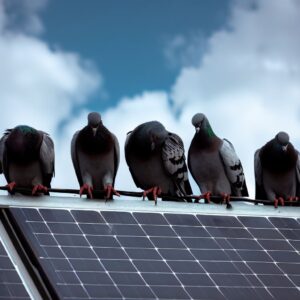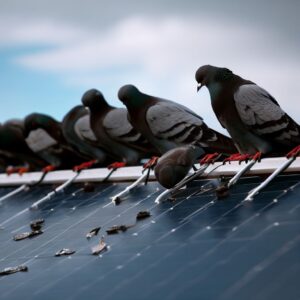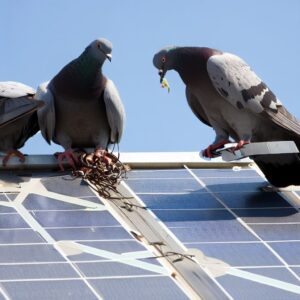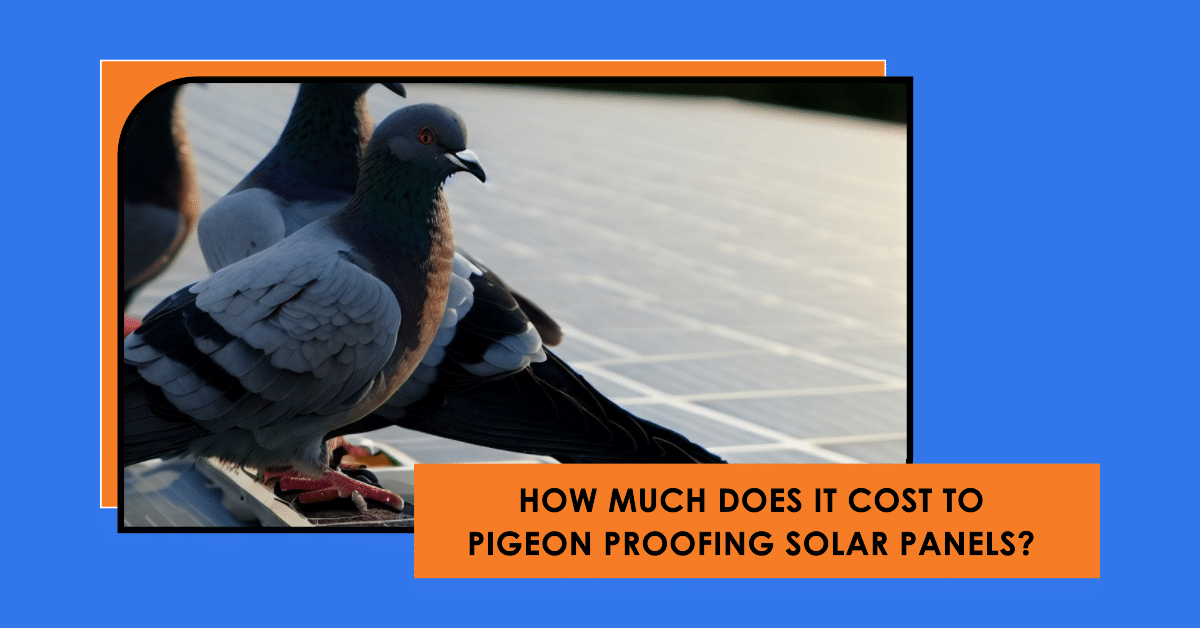Pigeon-proofing solar panels are a crucial consideration for homeowners and businesses with solar installations. Solar panels can face critical damage due to pigeon droppings, pollen deposits, and a dust layer. Frequent cleaning and birdproofing of solar panels are very essential.
These pesky birds can nest under solar panels, causing damage to the system and creating a mess. But how much does it cost to pigeon-proof your solar panels effectively? In this comprehensive guide, we’ll break down the costs involved in pigeon-proofing solar panels and explore the alternative top solutions available.
Along with we will discuss the potential damage due to pigeon nesting and dropping on solar panels. Also at the end, I’ll take you through what are the advantages and disadvantages of doing so.

Before moving forward here are the Key takeaways from the article:
- Pigeon-proofing your solar panels is essential to safeguard your solar installation from damage caused by pigeons nesting beneath the panels.
- The cost of effective pigeon-proofing varies depending on factors like the method chosen and the size of the installation.
- Pigeon-related damages include reduced energy production, panel corrosion, electrical component damage, reduced panel lifespan, aesthetic issues, and health concerns.
- The advantages of pigeon-proofing include maintaining energy efficiency, long-term savings, damage prevention, enhanced safety, and aesthetic benefits.
- Disadvantages encompass upfront costs, potential maintenance needs, installation complexity, and considerations related to local regulations.
The Cost of Pigeon Proofing Solar Panels:
Here’s a detailed tabular view of alternative methods for pigeon-proofing solar panels, including their upfront installation cost ranges:
| Pigeon-Proofing Method | Description | Upfront Installation Cost Range |
|---|---|---|
| Mesh or Netting | Install mesh or netting around panels to keep pigeons out. | $500 – $1,500 |
| Spikes or Deterrents | Use pigeon spikes, bird gel, or shock tracks to deter pigeons from landing on panels. | $300 – $1,000 |
| Clip-On Systems | Employ clip-on systems designed for solar panels to deter pigeons. | $200 – $600 |
| Professional Installation | Hire professionals to assess, recommend, and install a custom pigeon-proofing solution. | $1,000 – $3,000+ |
| Ultrasonic Devices | Utilize ultrasonic devices that emit sounds to deter pigeons. | $100 – $300 |
| Electric Tracks | Install electric tracks that provide a mild shock to pigeons when they land on panels. | $400 – $1,000 |
| Motion-Activated Devices | Use motion-activated devices like motion-activated sprinklers to scare away pigeons. | $50 – $150 |
| Visual Deterrents | Implement visual deterrents such as reflective tape or predatory bird decoys. | $10 – $50 |
Please be aware that those price degrees are approximate and may range primarily based totally on elements such as the size of the solar installation, location, and specific product or service providers. It’s really useful to acquire rates from experts or providers to get the correct pricing tailor-made to your particular situation.
Solar Panel Pigeon Proofing: Assessment, Cost and Factors
Now, Let’s discuss the problem assessment, methods of solutions, and additional factors that can fluctuate the estimated cost of pigeon-proofing solar panels.
Step 1: Assessing the Pigeon Problem- Before determining the cost, it’s essential to assess the extent of the pigeon problem. Factors to consider include the number of panels affected, the level of pigeon activity, and the geographic location.

Step 2: Pigeon-Proofing Methods/Options- There are several methods to pigeon-proof solar panels, each with its associated costs:
- Mesh or Netting: Installing mesh or netting around the panels is an effective way to keep pigeons out. Costs vary based on the size of the installation but generally range from $500 to $1,500 for a typical residential setup.
- Spikes or Deterrents: Pigeon spikes and deterrents, like bird gel or shock tracks, can deter pigeons from landing on the panels. Costs depend on the product used and the size of the installation, averaging between $300 and $1,000.
- Clip-On Systems: Some companies offer clip-on systems specifically designed for solar panels. These can be a cost-effective option, with prices ranging from $200 to $600.
- Professional Installation: Hiring a professional pigeon-proofing service can ensure a thorough and effective solution. Costs vary widely but can range from $1,000 to $3,000 or more, depending on the complexity of the job.
Step 3: Additional Factors Affecting Costs- Several factors can influence the overall cost of pigeon-proofing:
- Location: Prices may vary based on your geographic location and local service rates.
- System Size: Larger solar installations with more panels will naturally incur higher costs.
- Maintenance: Consider ongoing maintenance costs for some methods, such as cleaning mesh or replacing spikes.
Some Real-World Examples of Cost of Pigeon Proofing Solar Panels:
- Residential Solar Panel Installation: A typical residential solar panel installation with a mesh or netting solution might cost between $500 and $1,500. For instance, a homeowner in Phoenix, Arizona, with a 20-panel system may pay around $800 for pigeon-proofing.
- Commercial Solar Farm: Pigeon-proofing a larger commercial solar farm could be a more significant investment. A 100 kW solar installation in Los Angeles, California, may cost between $2,000 and $5,000 for comprehensive pigeon-proofing measures.
Damage caused by Pigeon on Solar Panels and their solutions:
Let’s understand why pigeon-proofing solar panels is a must for solar panel owners. Pigeons nesting on solar panels can cause various types of damage to the panels themselves and the overall solar energy system. Here’s an overview of potential damages and brief solutions for each of them:
Damage 1: Decreased Energy Production
Problem: Pigeon droppings and nesting materials can block sunlight from reaching the solar cells, reducing energy production.
Solution:
- Regular Cleaning: Routinely clean the solar panels to remove droppings, nests, and debris. Use a soft brush or sponge and mild, soapy water to avoid damaging the panels.
- Pigeon-Proofing: Implement effective pigeon-proofing measures to prevent birds from accessing the panel area in the first place.
Damage 2: Panel Corrosion
Problem: Pigeon droppings are acidic and can corrode the surface of solar panels over time, leading to permanent damage.

Solution:
- Immediate Cleaning: Promptly remove pigeon droppings from the panels to prevent corrosion.
- Pigeon Proofing- Anti-Corrosion Coatings: Apply anti-corrosion coatings to protect the panels’ surfaces from rust or any other damage.
Damage 3: Electrical Component Damage
Problem: Pigeons may peck at electrical wires and components connected to the solar panels, potentially causing electrical issues or shorts.
Solution:
- Professional Inspection: Regularly inspect the wiring and electrical components for damage. If any issues are detected, consult with a professional solar technician for repairs.
- Pigeon-Proofing: Implement pigeon-proofing measures to keep birds away from the panel area and wiring.
Damage 4: Reduced Panel Lifespan
Problem: Pigeon-related damage can lead to a reduced lifespan of solar panels, decreasing their long-term efficiency.
Solution:
- Preventive Measures: Implement preventive measures, such as bird deterrents, to keep pigeons away from the panels and prevent long-term damage.
- Regular Maintenance: Conduct regular maintenance and inspections to identify and address any damage promptly.
Damage 5: Aesthetic Issues
Problem: Pigeon droppings can create unsightly stains on the surface of solar panels, affecting the appearance of your property.
Solution:
- Cleaning: Regularly clean the panels to maintain their aesthetic appeal and efficiency.
- Pigeon-Proofing: Implement measures to deter pigeons from landing on the panels in the first place.
Damage 6: Health Concerns
Problem: Pigeon droppings can carry diseases and pose health risks to individuals working on or around the solar panels.
Solution:
- Safety Precautions: When cleaning or performing maintenance on solar panels, wear appropriate protective gear, including gloves and masks, to minimize health risks associated with pigeon droppings.
- Pigeon-Proofing: Prevent pigeons from nesting in the panel area to reduce health risks.
In summary, pigeons on solar panels can cause various damages, including reduced energy production, corrosion, electrical issues, reduced panel lifespan, aesthetic problems, and health concerns. Regular cleaning, maintenance, and the implementation of pigeon-proofing measures are essential for preventing and addressing these issues.
Pigeon Proofing Solar Panels: Advantages and Disadvantages

Deciding whether to go for pigeon-proofing your solar panels is a significant consideration for solar panel owners. Pigeon-proofing offers both advantages and disadvantages, and the decision should be based on your specific situation and priorities. Here’s a closer look at the factors to consider:
Advantages of Pigeon-Proofing Solar Panels:
- Maintains Energy Efficiency: One of the primary advantages of pigeon-proofing is that it helps maintain the energy efficiency of your solar panels. Pigeon droppings and nesting materials can block sunlight, reducing energy production. By preventing pigeons from accessing the panels, you ensure they operate at their full capacity.
- Long-Term Savings: By maintaining optimal energy production, you maximize the return on your solar investment. Over time, the energy savings can offset the initial cost of pigeon-proofing.
- Prevents Damage: Pigeon-related damage, such as corrosion, pecked wiring, and aesthetic issues, can lead to costly repairs or panel replacements. Pigeon-proofing helps prevent such damage, saving you from these potential expenses.
- Health and Safety: Pigeon droppings can carry diseases and pose health risks to individuals working on or around the solar panels. Pigeon-proofing enhances safety by reducing exposure to such risks.
- Aesthetic Benefits: Pigeon-proofing keeps your solar panels clean and free from unsightly stains, preserving the appearance of your property.
Disadvantages of Pigeon-Proofing Solar Panels:
- Upfront Costs: Implementing pigeon-proofing measures incurs upfront costs. The expenses can vary depending on the method chosen and the size of the installation. However, it’s important to consider these costs in the context of long-term savings and benefits.
- Maintenance: Some pigeon-proofing methods may require periodic maintenance to ensure their effectiveness. For example, mesh or netting may need cleaning, and deterrents may require occasional adjustments.
- Installation Complexity: Depending on the method selected and the configuration of your solar panels, installation can be complex. Professional installation may be necessary, adding to the overall cost.
- Local Regulations: Before pigeon-proofing your solar panels, be aware of any local regulations or homeowner association rules that may govern the installation of bird deterrents. Compliance with these rules may be required.
- Effectiveness May Vary: The effectiveness of pigeon-proofing measures can vary based on the specific bird population and local conditions. In some cases, determined pigeons may find a way around the deterrents.
Conclusion
In conclusion, whether to pigeon-proof your solar panels depends on your priorities and circumstances. The advantages include maintaining energy efficiency, long-term savings, damage prevention, improved health and safety, and aesthetic benefits. On the other hand, there are upfront costs, potential maintenance requirements, installation complexity, and considerations related to local regulations.
For many solar panel owners, the long-term benefits in terms of energy production, savings, and maintenance outweigh the initial costs of pigeon-proofing. Consulting with professionals in pigeon-proofing and solar energy can help you make an informed decision tailored to your specific needs and goals.




